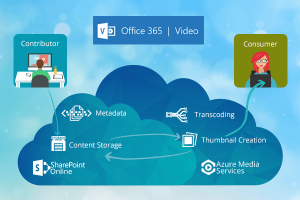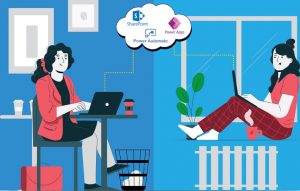Hello everyone, I am Yash Bhandari, a technology consultant at Softweb Solutions, an Avnet company. I welcome you all to a whole new podcast episode today.
In this episode, we are going to talk about how the ongoing COVID-19 pandemic is forcing enterprises to transform digitally and step into a new era of remote collaboration at a great length.
Before diving into this episode, let me tell you that there are many things that we could take as positives out of this gloomy situation like the rise of a new digital age, making work portable across time and space. These are things that we did consider in the past, but never realized how crucial they would become.
Until the beginning of the year 2020, digital workplaces were being spoken about, fueled by the need to save on resources and time. But very few companies thought of embracing the concept of digitizing work to create dynamic, work-from-anywhere experiences.
But five months into 2020 and the outbreak of the pandemic has eventually brought tectonic shifts in the world of work, forcing organizations to respond to these sudden shifts in requirements. Remote work is not new, but remote workplaces definitely are.
So, in the future, will the current situation be viewed as the dawn of a new era of remote collaboration? Or will it be seen as the beginning of the end of the traditional work culture in the history of the world of work? Or will it simply be seen as the emergence of digital workplaces for a specific time period as an emergency measure?
However, the current scenario will be foreseen in the future, one thing is certain: it has entirely changed the company culture and employee experience, leading organizations, all across the world, to adapt to new ways of working remotely, what the tech industry normally calls – a virtualized digital workspace.
We all know how the global outbreak has laid a far-reaching impact on businesses and individuals. In this situation, each one of us needs to stay stable and socially separated to work through this time of uncertainty. At Softweb Solutions, we are practicing safe and sound social distancing in compliance with the underpinning principles of the World Health Organization, enabling our employees to work seamlessly from the comfort of their homes. Thanks to the new-age remote collaboration technologies and dynamics of modern digital workspaces!
Looking at the aggravation of the situation, tech giants like Facebook, Alphabet (Google) and others have already made it official that they will let their employees work from home till the end of the year. Twitter also isn’t standing back, as it also announced to allow its workforce to work from home forever (if the employees chose to).
Okay, so now starting today’s episode, let us talk about one of the biggest challenges faced by organizations today, that is, converting their enterprise into a digital workplace and deploying tools and technologies that enable remote team members to work from home with ease and agility.
In different regions across several countries, remote work has become the new normal amid social distancing and lockdowns. And for your company to be able to sustain business continuity along with maintaining productivity of the remote workforce, it is necessary for you to adapt to the new way of working. But the question that might arise in your mind, right now, is how? All right, so we will answer your question in this episode, and help you to seamlessly enter into the complex world of virtualization.
Now, how your organization can transition to the digital workplace
Digital workplaces are fluid and yield a connected experience to a remote workforce with the help of next-generation digital technologies and remote collaboration tools or platforms. So, to enable the modern-day workforce to stay connected, motivated and truly productive, you need to build an intuitive remote work environment that can be accessed from anywhere, at any time using all the latest devices like laptops, smartphones, tablets, smart watches, tablets and other rugged devices.
SUBSCRIBE TO OUR PODCAST
Also, to ease your process of transitioning to a remote workplace, we have devised four steps in collaboration with our network of industry experts, which include:
- Consulting and technology assessment
- Optimize your current technology stack
- Spread awareness and set-up a remote culture
- Rapid modernization and scaling
So, basically you need to foster the utilization of virtual collaboration tools and practices in order to connect remotely with clients, customers, employees and partners and deliver more value in the new environment.
Cutting a long story short, the emergence of a new era of virtual work culture provides promising potentials to your company across numerous geographies. But to transform this utopia into a reality, you must embed a culture of remote collaboration and close interaction into your adaptive virtual workspaces. To swiftly transition to a remote work environment, I would suggest you focus on these six elements:
- First – inclusive remote environment
- Second – managed mobility
- Third – remote collaboration and communication
- Fourth – remote networking
- Fifth – cloud migration
- Sixth – ensuring security standards
Now moving onto the technological frontier
I also wish to share some technical information with you that will help you scratch the surface of digital workplaces if you want to deliver a boundary-less remote experience to your clients, partners and remote workforce. So, to start with, your remote workspace should be powered by the cloud, enterprise mobility and modernized security solutions along with virtual collaborative tools going across all the enterprise-grade virtualization technologies.
With the radical advancements in technology, you can also embrace innovative productivity and enablement-oriented solutions like:
- Remote access applications
- Public cloud platforms
- Creation of virtual desktops via AWS or Azure
- Data reporting and monitoring using Microsoft Power BI, Tableau, etc.
- Highly converged infrastructure
- Advanced software-defined network and much more
If you haven’t entirely digitized your workplace already, we highly encourage you to take a step forward and start mapping your business contingency plans by adopting a cloud-first strategy.
Now if you are wondering how your organization can respond to the pandemic strongly, keeping your digital transformation journey smooth and simple, then we suggest you to develop a robust contingency plan.
But, how will you increase your organization’s resilience in the face of COVID-19?
So, let us shift our focus a bit into how to respond strongly to the pandemic for a smooth transition to a digital workplace from traditional workplaces in tandem with the current times.
We have been observing that organizations that have previously enforced digital work practices are likely in a good position to respond rapidly to the demand of navigating the outbreak. If you are yet to digitize your work environment, then we support you to mount a holistic response, laying equal emphasis on securing your IT assets with the right set of security tools.
Apart from this, if you want to reflect certain aspects of the brick-and-mortar world of work into your virtual work culture, there are some intriguing platforms available in the market today, based on the Enterprise Social Network (ESN). These ESN services act as a social channel for your entire company that keeps your remote workforce bonded, informed and connected.
For example, Yammer from Microsoft and Workplace from Facebook are outstanding communication platforms, designed to connect and engage employees across the company, allowing them to share knowledge and build communities. So, basically it is like a social media platform but for your employees and your organization’s internal teams.
In the end, it is not only about work and productivity, but to move beyond the remote work culture that will strongly reflect your organization’s vision, brand image and ethics, creating a shared bond among your remote workforce.
Putting the entire episode briefly,
I would say that getting a blend and a fusion of technologies and work culture in silos is what will make the workforce of future success. So, we need to stay prepared and course correct our digital strategies by plugging the gaps, wherever required.
Come on, shake a leg to convert the COVID-19 crisis into an opportunity through a digital transformation, and start your digital workplace journey today. You can check out our remote working resource center that will provide you with tons of information on the best tools, technologies and practices to keep your business moving in a virtual work world, amid the crisis.
Let us now pray for the world and hope this kind of crisis never occurs in the future.
With this, I will end our podcast and I thank all of you for joining in. If you have any questions, feel free to contact me via my email address info@softwebsolutions.com I’d be happy to answer your questions. And for more information, you can visit our website.
Stay tuned to our channel and join us again soon for our next episode in our Digital Transformation series.
And most importantly – Stay safe.
Goodbye for now!









